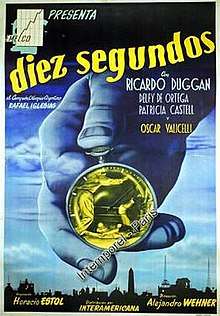Diez segundos
Diez segundos (Ten Seconds) is a 1949 Argentine film directed by Alejandro Wehner, produced by Emelco studios.[1] The film is a boxing drama starring Ricardo Duggan, María Esther Buschiazzo, Patricia Castell, Carlos D'Agostino (voice), Delfy de Ortega, María Rosa Gallo, Oscar Valicelli and Oscar Villa.[2] It premiered on November 23, 1949 in Buenos Aires. The film was distributed by Interamericana.[3] Castell and Rosa Gallo would later star alongside each other in several films and television series over several decades including Perla Negra and Zíngara (1996).[4][5][6]
| Diez segundos | |
|---|---|
 | |
| Directed by | Alejandro Wehner Carlos D'Agostino |
| Produced by | Ciriaco Hernández Carlos D'Agostino |
| Written by | Manuel Arellano Martín Horacio Estol |
| Starring | Ricardo Duggan María Esther Buschiazzo Patricia Castell Delfy de Ortega María Rosa Gallo Oscar Valicelli Oscar Villa |
| Music by | Juan Ehlert C. Sesso Ocampo |
| Cinematography | Antonio Prieto |
Production company | |
Release date | 1949 |
Running time | 83 minutes |
| Country | Argentina |
| Language | Spanish |
Plot


The film is loosely based on Horacio Estol's 1946 Vida y combates de Luis Angel Firpo, a biography of the Argentine boxer Luis Ángel Firpo who came close to beating Jack Dempsey in 1923.[7]
In the film, a humble lad starts to learn to box to defend himself, then goes on to become a professional boxer. He is trained heavily by Oscar Villa. Duggan's love interest in the film is played by Patrica Castell.
Cast
- María Esther Buschiazzo
- Patricia Castell
- Carlos D'Agostino
- Delfy de Ortega
- Ricardo Duggan
- María Rosa Gallo
- Oscar Valicelli
- Raul del Valle
- Oscar Villa
Reception

The book which the film was based on, Estol's Vida y combates de Luis Angel Firpo (1946) was received quite poorly and Wehner was inexperienced as a director, resulting in a disappointing film.[8]
A critic of the newspaper Noticias Gráficas said (in English): "They have used a narrative method that disappoints the viewer" and compared it to the delirium a boxer experiences when being knocked out. Diario Critica newspaper said (in English) "Some secrets of the technique get some interesting effects, but it reveals absolute nullity in the management of the interpreter."[9]
The authors of a 2009 analysis of the role of sports in Juan Peron’s government see the film as an example of the government’s pursuit of national advancement and social mobility through sporting achievement.[10] Its MALBA entry describes it as a classic Argentinian B movie and as a faithful, almost anthropological, representation of life in a Buenos Aires neighborhood of the time.[11]
References
- "Diez segundos". Cine.ar. Archived from the original on 4 April 2012. Retrieved 26 October 2011.
- "Diez segundos". Cinenacional. Retrieved October 26, 2011.
- Argentina. Comisión Nacional de Cultura (1950). Guía quincenal de la actividad intelectual y artística argentina. p. 76. Retrieved 26 October 2011.
- Dubatti, Jorge; Arreche, Araceli (2003). Teatro de grupos, compañías y otras formaciones: Micropoéticas II. Desde la Gente, Instituto Movilizador de Fondos Cooperativos Coop. ISBN 978-950-860-142-1. Retrieved 26 October 2011.
- Hernando, Gregorio Santos (1977). 25 i.e. Veinte y cinco años de TV Argentina. Editorial Herpa. p. 296. Retrieved 26 October 2011.
- "Perla Negra". Series Now. Archived from the original on 2012-04-01. Retrieved 26 October 2011.
- Argentina. Comisión Nacional de Cultura (1950). Guía quincenal de la actividad intelectual y artística argentina, Issues 57-68. p. 56.
- Roberto Blanco Pazos, Raúl Clemente (2004). De la fuga a la fuga: diccionario de films policiales. Corregidor. p. 89. ISBN 950-05-1528-8.
- Manrupe, Raúl y Portela, María Alejandra: Un diccionario de films argentinos (1930-1995) pág. 178 Buenos Aires 2001 Editorial Corregidor ISBN 950-05-0896-6
- "Esporte, cinema e política na Argentina de Juan Perón (1946-1955)" (PDF). Estudos Ibero-Americanos (Pontifícia Universidade Católica do Rio Grande do Sul). 2009. p. 69. Retrieved 2011-10-27.
- "Películas proyectadas - Diez segundos (Argentina, 1949)". Museo de Arte Latinoamericano de Buenos Aires. 2010. Archived from the original on 2012-04-05. Retrieved 2011-10-27.